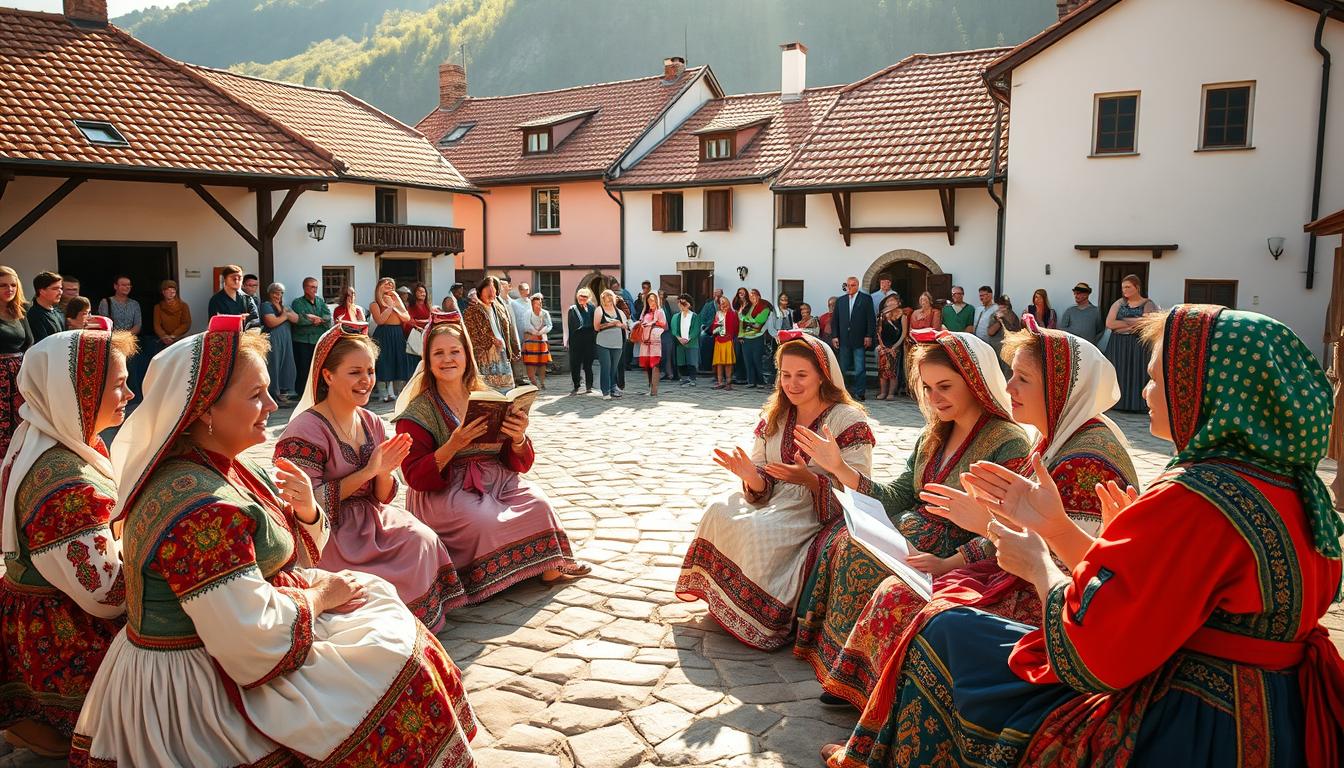Cultural identity in Southeast Europe carries layers of resilience and contradiction. The region’s history, marked by shifting borders and complex societal dynamics, has shaped generations. From the haunting legacy of 1990s conflicts to the quiet strength of daily life, these influences linger in traditions, art, and personal narratives.
Marina Abramović’s description of the Balkans as “a bridge where the wind blows” captures its poetic duality. Pride in ancestral roots often coexists with unresolved grief tied to collective trauma. This tension manifests in how communities preserve rituals while navigating modern expectations.
Traditional roles as caregivers and homemakers remain central, yet contemporary voices increasingly challenge stereotypes. External perceptions of the area often overshadow its nuanced realities. By exploring these intersections, this article aims to highlight untold stories of identity and belonging.
Key Takeaways
- Historical events continue to shape cultural identities in Southeast Europe.
- Artistic expressions, like Abramović’s work, reflect the region’s emotional complexity.
- Pride in heritage often intertwines with collective historical pain.
- Societal roles evolve while maintaining ties to tradition.
- External viewpoints frequently oversimplify local experiences.
Cultural Heritage and the Rich Traditions of the Balkans
The intricate tapestry of Southeast Europe’s traditions reveals how history weaves itself into daily life. Centuries of shifting empires and 20th-century conflicts left deep imprints on collective memory. These events shaped rituals, art forms, and intergenerational storytelling, particularly through female perspectives.
Echoes of the Past in Modern Identity
Klara Jovanov’s research highlights how wartime experiences still influence cultural practices. Oral histories passed down through families preserve resilience strategies developed during crises. This shared memory binds communities but also carries unresolved tensions between pride and loss.
Threads of Meaning in Fabric and Dance
Vibrant embroidered dresses and rhythmic folk dances serve as living archives. Each pattern symbolizes local legends or natural elements, while choreographed movements retell historical events. A 2021 ethnographic study noted that these traditions often spotlight female creativity, blending artistry with coded social commentary.
While media sometimes reduces these customs to nostalgic symbols, they remain dynamic tools for self-expression. Institutions now collaborate with artisans to digitize patterns, ensuring their relevance. Yet some communities grapple with shame tied to outdated stereotypes, revealing culture’s dual role as both anchor and burden.
The Influence of Media and Social Media on Perspectives
Digital platforms are rewriting how cultural stories get told in Southeast Europe. Activists and creators use these tools to spotlight issues often ignored by traditional outlets. Their work sparks debates about justice, equality, and societal norms.
Digital Narratives and the Role of Influencers
Podcast host Nina Pavičević tackles taboo topics like domestic violence through interviews with survivors. Her episodes on custody battles and legal reforms have gained over 50,000 followers. By sharing raw testimonials, she reshapes how audiences perceive systemic failures.
Instagram campaigns like #BreakTheSilence expose harassment cases through anonymous video submissions. These efforts challenge outdated stereotypes, pushing for accountability. A 2023 study found such content increases public support for survivors by 34%.
Media Coverage, Public Debates, and Shifting Perceptions
High-profile scandals, like Milena Radulović’s leaked court documents, reveal gaps in legal protections. News outlets initially framed the case as a private dispute, but social media users demanded transparency. Hashtags like #JusticeForMilena trended for weeks, forcing mainstream coverage.
Viral videos of a murder trial in 2022 shifted opinions about gender-based violence. Public pressure led to faster reforms in protective laws. However, polarized debates online sometimes deepen divisions, showing both the power and risks of digital activism.
Gender Roles, Institutional Challenges, and Cultural Expectations
Tradition and modernity collide in Southeast Europe’s societal structures. Cultural norms often frame women as caretakers first—mothers, wives, and silent supporters. This duality creates friction in academic and professional spaces where ambition clashes with inherited expectations.
Academic Encounters and Cultural Shame
A 2022 interview revealed how professors dismissed female students’ research on gender equality as “divisive.” One scholar recounted being told her work “threatened family values.” Such interactions reinforce a sense of shame tied to challenging traditional roles.
Systemic Barriers within Judicial and Political Systems
Legal frameworks often fail survivors of violence. In Milena Radulović’s custody case, courts prioritized the father’s financial status over documented abuse claims. Similarly, Ozren Prohić—a convicted rapist—received a suspended sentence despite overwhelming evidence.
Klara Jovanov’s research highlights systemic patterns: only 12% of domestic violence cases result in convictions across the region. Political institutions rarely prioritize reforms, leaving outdated laws intact. Activists argue this erodes trust in systems meant to ensure protection.
Collective efforts to redefine cultural narratives now challenge these norms. Public debates sparked by news coverage of high-profile cases reveal growing demands for accountability—and change.
Empowering Balkan Women: Challenging Stereotypes and Systemic Barriers
Grassroots movements across Southeast Europe are amplifying voices long silenced by outdated norms. Initiatives like the ‘ICON’ retreat and digital campaigns led by activists such as Pamela Perkić demonstrate how creativity and technology fuel progress. These efforts blend artistry with advocacy, reshaping perceptions while addressing systemic gaps in protection and representation.
Inspirational Voices and Grassroots Movements
Pamela Perkić’s social media campaigns spotlight survivors of violence through video testimonials. Her posts, reaching over 200,000 followers, combine raw storytelling with calls for legal reforms. One viral video exposed how institutions dismissed a survivor’s plea, sparking nationwide protests.
The ‘ICON’ retreat unites artists and activists to foster solidarity. Participants share strategies for navigating cultural shame, transforming personal experiences into collective action. A 2023 survey found 78% of attendees reported increased confidence in challenging stereotypes after attending.
Reclaiming Narratives and Paving New Paths
Local theater groups now reinterpret folk tales to highlight female resilience. One play reimagines a traditional legend as a story of legal triumph against a rapist, drawing sold-out crowds. Such projects counter harmful narratives while preserving cultural roots.
| Initiative | Focus | Impact |
|---|---|---|
| #BreakTheCycle Campaign | Legal Education | 12,000+ petitions signed |
| Artists for Change Network | Cultural Storytelling | 40+ exhibitions hosted |
| Digital Safety Workshops | Online Protection | 3,500 participants trained |
Social media platforms enable real-time responses to injustice. When a court reduced a perpetrator’s sentence last year, activists flooded timelines with facts about sentencing disparities. This digital pressure led to an appellate review—proof that visibility drives change.
Conclusion
The journey of resilience in Southeast Europe reflects a constant dialogue between heritage and progress. Media campaigns and podcasts amplify once-silenced voices, transforming shame into collective action. High-profile trials—like the 2022 murder case that sparked legal reforms—reveal cracks in judicial systems while proving visibility drives change.
Grassroots movements redefine success by merging tradition with modern advocacy. Digital platforms dissect outdated norms, holding institutions accountable through petitions and viral messages. Yet daily struggles persist, as cultural expectations often clash with hard-won rights.
Progress demands solidarity. From courtroom battles to social media campaigns, each step forward underscores the need for systemic protections under the law. Recognition grows for those rewriting narratives, but lasting equity requires sustained engagement.
Their stories remind us: resilience thrives where history and hope intersect. Supporting these efforts means honoring both struggle and triumph—one day, one voice at a time.







